|
 |
|
Background
Aaron Manby and his partner
Joseph Smith, founded and ran the Horseley
Ironworks, which began life as the Horseley Coal
and Iron Company, with coal mines, ironworks and
an engineering factory.
Aaron Manby (1776 to 1850)
Aaron Manby was born on the 15th November, 1776
in Albrighton, Shropshire. He was the second son
of Aaron Manby of Kingston, Jamaica and Jane
Lane, of Bentley Hall. His early years were
spent at Cowes, on the Isle of Wight where he
started his career working in a bank. On
the 14th September, 1800, Aaron married Juliana
Fewster, at St. Anne's Church, Soho,
Westminster. They had a son, Charles, who was
born at Cowes on the 4th February, 1804. Sadly.
Aaron's wife, Juliana, died in July 1806 and is
buried at Cowes.
On the 15th August, 1807, Aaron married his second wife, Sarah
Ann Haskins, at Newbury, Berkshire. They had one daughter,
Sarah, and three sons: John Richard (1813-1869),
Joseph Lane (1814-1862) and Edward Oliver
(1816-1864), who all became civil engineers and
worked mainly abroad. Sadly, Sarah Ann died on the
4th September, 1826, in Paris.
Aaron joined the Horseley
Coal and Iron Company, which had been formed in
about 1770. By 1812 he was a managing partner in
the concern and quickly developed the
engineering side of the business, which
initially concentrated on the manufacture of
marine steam engines. In 1813 he was granted a
patent for the manufacture of building bricks
and blocks that were cast from furnace slag. The
earliest known Horseley marine engine was built
in 1817 for the ‘Prince of Coburg’ steamship,
which sailed between Cowes and Southampton. The
firm also began to design and build bridges, the
first of which may have been
a
cast iron swing bridge, built at the East India
Docks, London in 1816.
In 1821 he became a member
of the Institution of Civil Engineers and on the
9th July, 1821, was granted a patent for an
oscillating marine steam engine. The first of
which, was built and operated with the help of
his son, Charles. Another of Aaron’s patents at
that time was for the use of oil to get-up steam
in a marine engine. Aaron became very
interested in France and took out French
patents for his oscillating engine and for the
design of an iron ship. He became involved with
Captain Charles Napier who was greatly interested in
iron-hulled ships and hoped to eventually develop an
iron warship.
|
|

Admiral Sir Charles John
Napier. |
Charles Napier was a British naval officer
who fought in most of the major wars in the
first half of the 19th century and had a
distinguished military career. He became a captain in
1809, was knighted in 1840, became the Liberal
MP for Marylebone in 1841, then a rear-admiral
in 1846 and a vice admiral in 1853.
He became a Radical MP for Southwark
in November 1855 and again in 1857. In 1859 he
became Liberal MP for Southwark.
He died in 1860 at the age of 74 and is
buried in the churchyard at All Saints Church, Catherington, in Hampshire.
There is a memorial to him in St. Paul's
Cathedral.
For many years he tried to persuade the
powers that be, to develop iron-hulled steam
warships. |
|
Manby and Napier formed a company in
France to operate
steam boats on the River Seine between Rouen and
Paris. Their first iron boat, built at Horseley
works was financed by Napier and registered on the 30th April, 1822
as ‘Manby’, although it was generally known as
the ‘Aaron Manby’.
After successful trials, the
ship crossed the channel and became the first
iron ship to put to sea. It successfully
operated on the Seine for about thirty years. Manby and Napier then ordered a second, slightly
larger iron boat called the ‘Commerce de Paris’
which was completed in 1823 and powered by
engines built in France at Manby’s engineering
works. Napier financed the building of several
other iron steamboats until the business was
declared bankrupt in 1827.
Between 1819 and 1822,
Aaron Manby established
an engineering works at Charenton, near Paris,
with Daniel Wilson as manager. He then severed
his connections with the Horseley works,
concentrating on his interests in France. The
Charenton business, called Manby, Wilson and
Company became known as the ‘Compagnie Anglaise’
and survived until 1847. The firm employed
around 500 people. Daniel Wilson was a chemist
who patented the use of ammonia to
remove hydrogen sulphide from gas. The business
included a gas lighting company called Manby and
Wilson's 'Compagnie d'Éclairage par de Gaz
Hydrogène', or in English, the Hydrogen Gas
Lighting Company. They received orders for the
provision of hydrogen gas lighting in parts
of Paris.
In 1826, Manby purchased
the ‘Le Creusot’ ironworks which amalgamated
with Manby, Wilson and Company in 1828 to form
the ‘Société Anonyme des Mines, Forges et
Fonderies du Creusot et de Charenton’. Aaron Manby returned to England in about 1840
and lived for a while in Munster Road, Fulham.
In 1845 he sold Horseley Ironworks to John
Joseph Bramah, the nephew of the inventor
and locksmith Joseph Bramah. Aaron Manby then
moved to Ryde, on the Isle of Wight, and later
to Shanklin, where he died on the 1st December
1850,
at the age of 74.
Charles Manby (1804 to 1884)
Charles Manby was born in Cowes on the Isle
of Wight on the 4th February, 1804 and educated
at a Roman Catholic seminary, followed in 1814
by a year at the Saint-Servan College, near
Rennes, in France. In 1817 he joined his
father’s business at Horseley Ironworks and
trained as an engineer. After assisting his
father in the ‘Manby’ paddle steamer project, he
helped to install hydrogen gas pipes in Paris
for his father’s company and worked for his
father at a gas works at Ternes. He then
reorganised his father’s Le Creusot ironworks
before working for the French Government to help
with the building of France's state-owned
tobacco factories.
He returned to the UK and was in control of
the Beaufort Ironworks at Blaenau Gwent, where
he married Ellen Jones in 1830. After working in
Bristol and London he became Secretary of the
Institution of Civil Engineers, from November
1839 until 1856. In 1853 he was elected as a
Fellow of the Royal Society and in 1856 became
the London representative of locomotive
manufacturer, Robert Stephenson & Company. After
the death of his first wife, he married Harriet
Willard, in 1858.
Charles joined the International Scientific
Commission on the Suez Canal, based in Paris and
received a number of international honours
including the French Legion of Honour and a
knighthood by the Italian Order of Saints
Maurice and Lazarus. He died at his home on the
31st July,1884 at the age of 80. He lived at 60
Westbourne Terrace, Paddington, London, where he
is commemorated by a blue plaque.
The Paddle Steamer
Aaron Manby formed the
steamboat operating company in France, with
Captain Charles Napier, who had the idea of
operating steamships on the Seine. They were
assisted by Charles Manby in the design of an
iron paddle steamer to operate on the Seine. It
was patented in France and built at Horseley,
before sailing to France.
The boat was 106 feet 10
inches long, and 17 feet 2 inches wide. The
flat-bottomed hull was made from ¼ inch thick
iron plate fastened to iron ribs and powered by
a 32 horsepower, two cylinder oscillating steam
engine. The cylinders were 27 inches in diameter
with a stroke of 3 feet. The steam was 2 lbs above
atmospheric pressure and the funnel was 47 feet
high. The paddles were of a type designed by the
Irish engineer, John Oldham. They had a radius
of 6 feet and were 2½ feet wide. The top speed
was about 9 knots and the draught was one foot less
than any other contemporary steamboat.
|
|
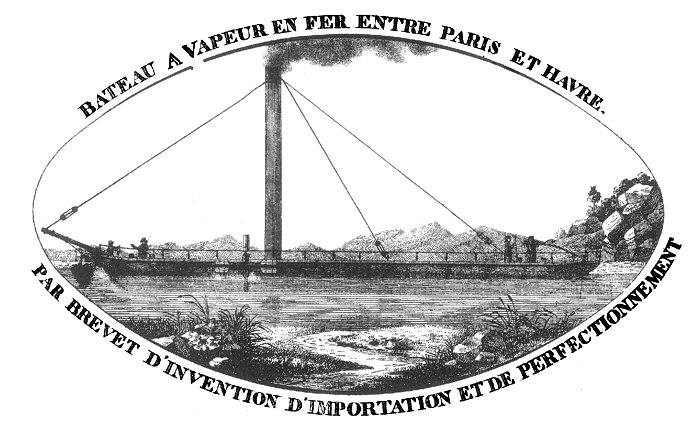
The steamship 'Manby'. |
|
After completion, the boat
was transported in pieces by canal to
Rotherhithe and assembled at the Surrey Canal
Dock. The boat was then registered on the 30th
April, 1822 under the name of ‘Manby’, but was
generally known as the Aaron Manby.
After trials on the River
Thames, the ship sailed to Rouen via Boulogne,
captained by Charles Napier, with Charles Manby
on board as ship’s engineer. The ship arrived at
Boulogne on the 18th May, before reaching Rouen
on the 27th or 28th May. It then sailed along
the Seine to reach Paris on the 10th June, 1822.
It carried passengers and a cargo of iron
castings and linseed. It was the first iron ship
to go to sea.
The ship made other voyages
along the channel but was mainly used for
pleasure trips along the River Seine.
Unfortunately, Napier and Manby’s sailing
company was declared bankrupt in 1827. The
paddle steamer Aaron Manby was sold in 1830,
along with the company's other boats, to a
French consortium "Compagnie des bateaux a
vapeur en fer". The Aaron Manby then operated on the River Loire
until the 1850s. It was broken up for scrap in 1855.
In 1972 the Black
Country Society produced a bronze medallion to
commemorate the 150th anniversary of the
building of the Aaron Manby.
|
|

The Black Country
Society's bronze medallion. |
|
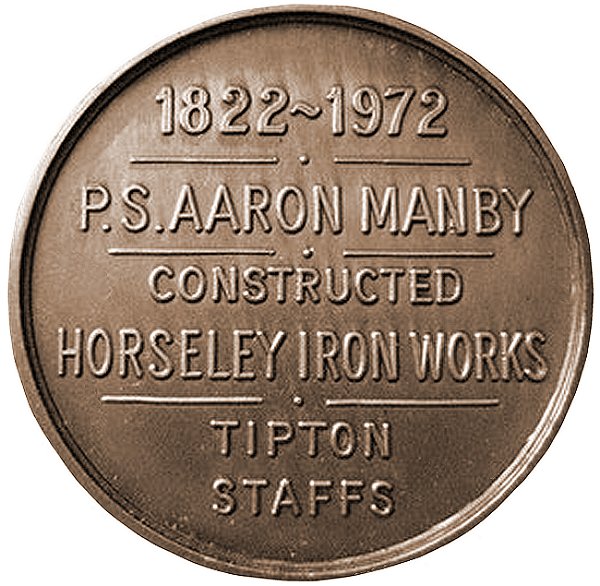
The other side of the
medallion. |
|
Commemoration
The friends of Tipton
Library are organising a series of talks and
events to commemorate and celebrate things that
happened in the past. Much of this is thanks to
the excellent work carried out by Richard
Jeffcoat. The Libraries in Tipton used to be
managed by Robert Hazel, who is now retired. He
made them friendly places to visit, so that they
are now part of the community and helpful in
every way.
One of the events, which
took place on Friday the 29th April, 2022 was
the unveiling of a blue plaque to mark the 200th
anniversary of the building of the steam ship,
Aaron Manby. The plaque was produced by Tipton
Civic Society and installed on the front wall of
the Joseph Turner Primary School, in Powis
Avenue. The plaque was unveiled by local MP.
Shaun Bailey and was followed by a brief talk
given by Derek Nicholls, along with
refreshments, at Glebefields Library.
|
|

The plaque. |
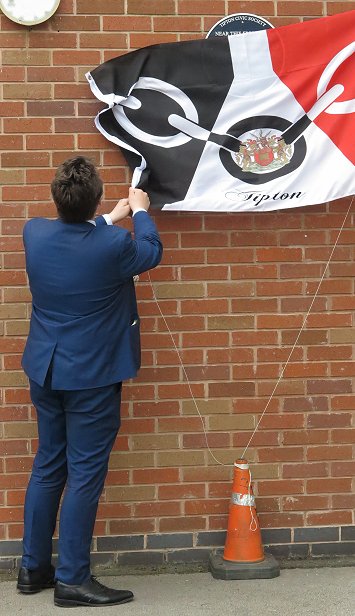 |
|
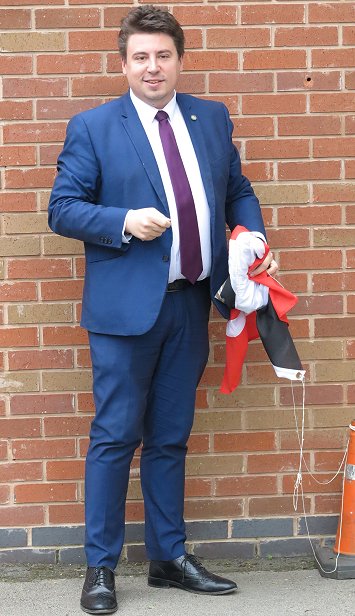 |
|
Shaun
Bailey unveiling the plaque. |
|
Shaun
Bailey. |
|
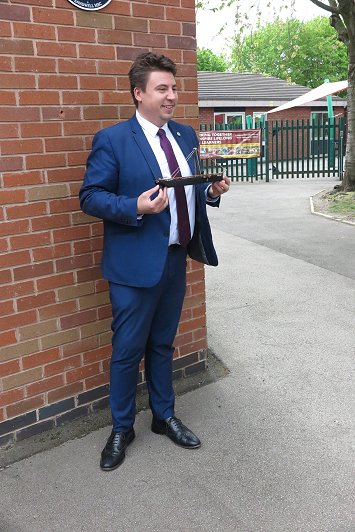 |
|
 |
|
Shaun
Bailey holding a model of
the paddle steamer. |
|
Derek
Nicholls. |
|
 |
Return to
the
previous page |
|